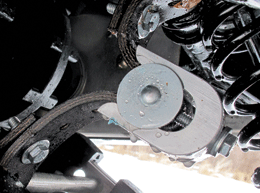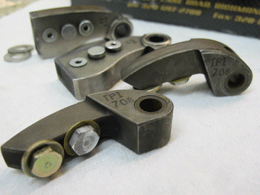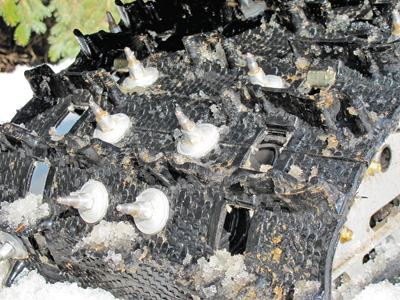AD Boivin Composite Suspension Tested/Stud Boy Power Point Studs Tested/Curve XS Skis Tested/Spectro Oils Wash Tested
AD Boivin ZX2 Composite Suspension
Snowmobilers are a skeptical bunch of armchair engineers. So, fitting as it was, the Snow Goer staff questioned whether AD Boivin’s ZX2 Composite Suspension would hold up to the abuse it could face on the trail or in the mountains. Snowmobiles run in harsh environments and they’ll be shredded if built with inferior materials or designs.
What about the exotic suspension’s performance? Stock suspensions work better than ever these days, so it would be a shame to drop a grip of cash on an aftermarket skidframe only to get a rough ride and clumsy handling. There’s but one way to find out whether our uncertainty was warranted: get a ZX2 and try it out.
We bolted a ZX2 suspension in our 2008 Polaris 700 SwitchBack demo sled late last winter and rode the machine every chance we had in order to test its ride quality and durability. After logging 1,000 miles on the ZX2, we were confident in its integrity and sure of its ideal customer.
Measure Many Times, Drill Once
Swapping a rear suspension is serious work. It involves an accurate layout with spot-on measurements and carefully drilled holes that will put the skid square within the chassis. Put it in the wrong spot and a machine might ride and handle poorly or be terribly inefficient. ZX2 installation was no less complex.
Assembly took about two hours under guidance from the bi-lingual instruction manual (AD Boivin is a French-Canadian company based in Levis, Quebec). The bushings and shafts fit well and the job was simple. Our kit was for a 136-inch track, so it required the accessory rail extension kit. We had to remove material with a file from the aluminum connectors — which support the extenders — in order to press them into the rail opening. This accounted for 30 minutes of the job.
Don’t expect to quickly bolt the ZX2 suspension in the tunnel late one night and head out for a trip the next morning. We learned the job is best left to a shop that has proper tools, equipment and experience to retrofit suspensions. We assembled the skid and hired Straightline Performance in Forest Lake, Minnesota, to install the suspension. It took the company more than 10 hours to do the job.
Though not even suggested in the installation manual, Straightline found it necessary to remove the track to accurately find the center-point of the driveshaft, which is where the new suspension mount holes are based. The instructions were generalized and did not include correct dimensions to mount the suspension in our Polaris. It took countless trials and re-measurements to come up with the correct layout. Once that was determined, the stock front mount plates had to be removed so Boivin’s aluminum brackets could attach inside the tunnel.
Ride Impressions
Once we put the machine on the snow, we noticed a nearly identical ride and feel compared to our SwitchBack’s stock suspension. One concern we had going into this test was how the new suspension would affect the hybrid sled’s handling, but the sled cornered precisely with the ZX2 and it stayed flat through high-speed corners. Ride height was near stock — if anything, it was slightly lower — and the machine felt equally stable and predictable through turns and at all speeds.
Bottoming resistance from the dual-shock rear torque arm was as good as the stock skidframe, but its compression stroke ended less abruptly when it mowed over the bumps. Performance through big G-bumps was definitely an improvement, as we didn’t feel the hit we’d grown accustomed to with the IQ skidframe. One staffer thought the stock suspension was comfortable on stutter bumps but it bottomed when jumping road approaches or landing in a hole. With the ZX2, he was never able to bottom out and it felt stiffer on stutter bumps.
While testing in the deep snow near Cooke City, Montana, we realized the ZX2’s tall rails don’t evacuate snow well. At 57.5 pounds, the aftermarket suspension weighed 4.5 pounds less than the Polaris suspension, but the amount of snow that accumulates between the rails is enough to negate any weight advantages of the composite system. Once the sled returned to a groomed trail, the snow cleared out.
Adjustments And Durability
At the end of the season, our ZX2 showed no signs of breaking down and we don’t see reason to believe it won’t hold up for the life of a sled. Instructions said to re-torque fasteners and adjust the track after 200 miles (composite material expands and contracts with temperature swings, so proper track tension is critical); when we did, all bolts were snug and the track was in spec. The only problem we had with the suspension was that two of the four suspension adjustment pins fell out.
For simplicity, Boivin uses a pin that pushes in a hole to set the Revolver System suspension adjustments. The system is slick, but reliability is more important. We installed 5/16-inch bolts and replaced the other two original pins with ones that couldn’t fall out. This made adjustments more complex, but because most people will set the suspension and forget it after a few hundred trial miles, the quick-adjustment pins should be replaced with parts similar to what we used.
Our luck with suspension adjustments was a mixed bag. The suspension kit includes a tool that has a spanner wrench on one end to adjust spring preload. It worked well on low-tension preload settings, but when we tried to adjust the stiffest two or three clicks, the wrench slipped off the collar. Patience and countless trials eventually let us make the adjustment.
For weight transfer, two holes can be used but we relied on the setting recommended by Boivin. Coupling can be set in one of three holes, and those adjustments were easy. We just pulled the pins, inserted the tool to turn the revolver and re-inserted the pins to hold the new setting.
A Good Value
For our money, a ZX2 is best for a high-mile, late-model sled like a Polaris Gen II model, Cat ZR or Yamaha Pro Action-equipped machine that has a worn out rear suspension or is in need of a ride-quality upgrade. At only $1,199 (mount kits cost $99), the ZX2 is an excellent value for someone who’s looking to get a better ride and updated technology in a durable skidframe. — Andy Swanson
Ride quality: 1.8/2
Instructions: 1.3/2
Durability: 2/2
Value: 2/2
Ease of adjustment: 1.5/2
Total: 8.6/10
AD Boivin
Levis, Quebec
418/838-3783
www.adboivin.com
Stud Boy Power Point + Plus Studs
“Perfect” is the word that best describes our 2008 Ski-Doo MX Z TNT demo sled’s grip with 84 +Plus studs and a set of 6-inch Stud Boy Shaper Bars.
Stud Boy’s +Plus stud was designed specially for new REV-XP sleds that roll on the Camoplast single-ply tracks. The studs have an industry standard 60-degree tip for good penetration and durability, but the differences are in construction.
The +Plus stud’s base is slightly more than 1-1/8 inches diameter, compared to the 1-inch base of standard Power Point studs. Single-ply tracks have less track material to support the stud, so Stud Boy increased the base diameter to resist pull-through. The base is thinner, too, to reduce weight.
After we logged more than 2,000 miles, the studs were in good condition with normal wear to the leading edges of the shanks. The carbide tips were in place and just a few studs were slightly bent. Only one was broken.
We used 1.080-inch studs in our track with 1-inch lugs, but Power Point +Plus studs are also available in 1.187- and 1.375-inch lengths. A pack of 84 +Plus studs retails for $192.99, which is right in line with the price of other studs. They require special Stud Boy backer plates, too, so don’t forget those when assembling your own traction setup. — Andy Swanson
Traction: 2/2
Durability: 1.8/2
Installation: 2/2
Appearance: 1.8/2
Price: 2/2
Total: 9.6/10
 Stud Boy
Stud Boy
Ravenna, Michigan
231/853-2323
www.studboytraction.com
R.U. Outside Tundra Boot
My favorite features of the boot are comfort-related. The insulated liner is soft and securely holds my foot. They’re flexible in the ankle for easy riding or walking and waterproof even if the foot is fully submerged. The liner goes in and out easily, especially with the use of the oversized leather pull-strap on the back of the boot. The boots were warm for most winter temperatures; when I stood outside for hours at a snowmobile race in minus 20 degree F temperatures, I assisted my comfort with a chemical foot warmer pack. (The boot is rated to minus 50 degrees F.)I got first dibs on the latest R.U. Outside boot design — the Tundra — and the company has come a long way since it started peddling snowmobile footwear more than 10 years ago. The Tundra looks like a hiking boot, with a rubber sole, leather and nylon construction and cool striping. In a way, they felt a bit like hiking boots, too. While they don’t have the hiking-style ankle support, they’re do-all boots for most outdoor winter functions.
My complaints about the boot are more practical-related: the laces are too long (with no place to tuck the extra length) and it’s difficult to cinch the top for a secure seal around the calf. The tan leather became quite dirty (particularly on the toe) from rubbing in snowmobile foot wells. And then there was the hook issue — which turned from “complaint” into “compliment.”
Toward the end of the season, the plastic lace hook — the one that secures the boot up top — snapped off. I called the R.U. Outside customer service number, left a message, and received a return call within the hour. I was told to return the boots for a replacement pair, no questions asked. It was a refreshingly simple interaction. RU Outside owner Rick LaBelle said that the plastic hooks were phased out by early winter and that the majority of boots delivered last season have durable metal hooks.
The boots have a retail price of $160, but I’ve seen them as a website special for $130. They’re available through RU Outside’s web- site, catalog or at snowmobile shows. — Lynn Keillor
Comfort: 1.7/2
Waterproof: 2/2
Lacing: 1/2
Style: 1.8/2
Customer service: 2/2
Total: 8.5/10
R.U. Outside
Driggs, Idaho
800/279-7123
www.ruoutside.com
Curve Industries CurveXS Skis

It’s surprising how a set of skis can dramatically affect how well a snowmobile handles. Without a doubt, the black-and-blue CurveXS skis we tested last season calmed down the front end of our Yamaha FX Nytro ER. We were able to ride the machine with more confidence and as a result the machine was more fun.
In stock form, there seems to be a fine line between adequate traction up front to keep the Nytro on course and too much bite that causes the machine to seek its own route. When we installed the CurveXS skis last winter, we hoped to reduce darting on deceleration, pushing through turns and a generally unpredictable nature.
Curve Industries included an untraditional set of wear bars; Stud Boy Shaper Bars with two, 1.5-inch chunks of cutting carbide that were separated by 4.5 inches of carbide wear pad. Each piece of cutting carbide was equally spaced in front and behind the ski’s spindle mount hole. The wear bar’s bolt pattern is the same as prescribed for C&A Pro skis (Stud Boy 2198 series).
The CurveXS’s keel is 1-inch wide where it contacts the ground and spreads to 3 inches wide at the ski sole. The keel has a lot of contact area, but it’s not as hyper-aggressive as some other aftermarket skis due to its taper. This ski and bar’s profile holds the snow and seems to be the right balance between hook-up and slip for the Nytro. The skis held the trail but released a little traction for comfortable steering effort and predictable tracking.
As expected, the plastic skis proved to be super durable. At 9.25 pounds apiece (with hardware, ski rubber and carbide), they’re on the heavy side, but their tough construction is clean, well-engineered and durable — all important attributes. Aside from the normal scuffs and scrapes, they’re in perfect shape after more than 700 miles. There aren’t discolorations, cracks or stress marks.
Granted, there’s more than one way to improve a sled’s handling characteristics, but we’re convinced that the CurveXS skis and Stud Boy’s specially designed Shaper bar is one of the easiest and best for a Yamaha Nytro. CurveXS skis fit Arctic Cat, Polaris and Ski-Doo sleds, too. They retail for $429; hardware, sled-specific spindle rubbers and bushings kit is $37.99. — Andy Swanson
Fit: 1.9/2
Value: 1.7/2
Price: 2/2
Ease of use: 1.9/2
Versatility: 1.8/2
Total: 9.3/10
Curve Industries
Waterville, New York
315/292-0594
www.curveXS.com
Spectro Oils XL-1 Motorcycle Wash
I’ve washed literally hundreds of sleds over the past 15-or-so years with a sponge and bucket of soap and water, but Spectro’s XL-1 spray-on motorcycle wash is an excellent way to quickly clean a sled’s grime that accumulates after a weekend on the trails.
XL-1 is great for two reasons: it cleans up a mess very well and it’s easy to use. I just sprayed it on the sled and rinsed it off with cool water from a garden hose. As I rinsed the surface, the foaming bubbles cut through the crud and carried away the crud from the hood, side panels and tunnel.
Under the hood, it cleared away belt dust and restored the luster from metal parts. The powerful (and comfortable) trigger and sprayer are sturdy and they reliably shot a high-pressure stream of cleaner right where I aimed.
I learned that a little XL-1 goes a long way. It produced a surprising — heck, amazing! — amount of cleansing foam when I splashed it with water.
Other Snow Goer staffers used it to clean motorcycles, ATVs, lawn mowers and dirt bikes, too. Brake dust slid right off of aluminum car and truck wheels.
XL-1 is sold through snowmobile and motorcycle shops across the country. Retail price for a 34-ounce bottle is $13.34. If you can’t find it at a local store, view the company’s website to find a distributor. — Andy Swanson
Packaging: 2/2
Effectiveness: 2/2
Price: 1.6/2
Ease of use: 2/2
Versatility: 2/2
Total: 9.6/10
Spectro Oils of America
Brookfield, Connecticut,br>203/775-1291
www.spectro-oils.com



